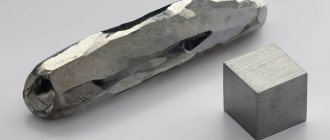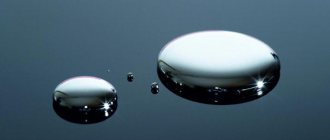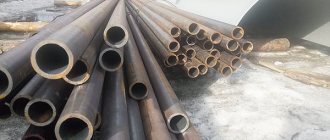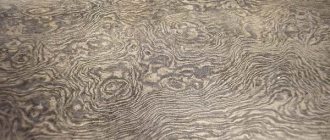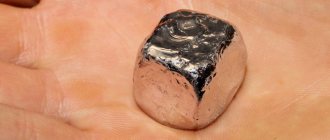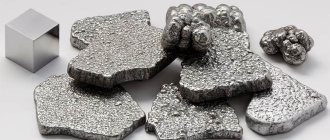Diamond is rated a 10 on the Mohs hardness scale, indicating that it is the hardest natural material when scratched. However, lonsdaleite, a substance found in meteorites, is predicted to be even harder than diamond.
Ask any science buff, “what is the hardest material?” - and he will undoubtedly answer: “Diamond.”
For decades, people have used diamond's flawless hardness for intensive cutting. Additionally, given its ability to interact beautifully with light, diamonds are a highly desirable piece of jewelry for women. But is diamond really the hardest material on Earth?
Well, almost... scientists have discovered a potential contender that is believed to be even harder than diamond.
What is graphene and why is it so unique?
Carbon is a material consisting of a crystal lattice formed by hexagons of atoms. Graphene is a single lattice layer 1 atom thick. Hence its first unique property: it is very thin.
- graphene is 60 times thinner than the smallest of viruses.
- 3 thousand times thinner than bacteria.
- 300 thousand times thinner than a sheet of paper.
This is what the structure of carbon looks like. If you separate one of the layers, you get graphene
Graphene, moreover, is also an excellent conductor of electric current, although it has the structure of a semiconductor. Graphene has good thermal conductivity, flexibility and elasticity, and is 97% transparent. At the same time, graphene is the strongest known material: stronger than steel and diamond.
Spider silk is one of the strongest materials on Earth
Despite its amazing properties, stumbling upon a cobweb, especially in the forest, is extremely unpleasant
In fact, spider silk is one of the most durable natural materials on our planet. As you probably know, spiders use webs to catch prey and protect their offspring. Although the strength of spider silk varies from species to species, spider silk is almost as strong as high-grade steel. Agree, this is quite serious. That's why Spider-Man from the notorious fictional universe is able to use spider silk so famously and usefully. Perhaps in the future, spider silk will be used as muscles for robots. Read more about this amazing proposal from scientists in the material by Ilya Khel.
Where is graphene already used?
Now graphene is successfully used in electronics. The most popular product is a power bank: manufacturers promise that it charges itself in 20 minutes, and a top-end smartphone charges halfway in half an hour.
There are also graphene jackets and dresses
. The latter, in particular, are equipped with LEDs that respond to breathing and body temperature by changing color.
Tennis rocket
with graphene weigh up to 300 grams less than conventional ones, with the same impact force.
Finally, machine oil
with graphene is designed to reduce engine wear.
Graphene could be used to treat cancer
There is one more property of graphene: it is biocompatible, that is, it interacts with living cells. Scientists promise that the material will help diagnose and treat cancer. This is done using a graphene chip, which gives increased sensitivity. Cancer cells are planted on the surface of the chip and various drugs are tested on them.
Such chips can also be used to test other drugs, as well as to determine biomarkers: immunoglobulin, DNA, neuronal bioreceptors.
Diamond is the hardest natural mineral
This is what diamonds look like before they are given to their loved ones.
Diamond is the hardest known natural mineral ever found on our planet. Another amazing property of this natural mineral is its ability to exist indefinitely. It should be noted that diamond is a rare, but at the same time quite widespread mineral. Industrial diamond deposits are found on all continents except Antarctica. With a variety of colors available, diamonds are used in a wide range of industries, including manufacturing. At the same time, despite its hardness, a diamond is very easy to scratch - but only with another diamond. There is still no exact scientific data on the origin and age of diamonds, although according to some studies, its age can vary from 100 million to 2.5 billion years.
To always keep abreast of news from the world of popular science and high technology, subscribe to our news channel on Telegram
Moreover, meteorite diamonds are known to be of extraterrestrial origin, since this hardest natural mineral on Earth is also formed by the impact of large meteorites falling on our planet. However, diamond acquires its most amazing property after scientists place it in a vacuum or leave it under the influence of an inert gas - at elevated temperatures, this mineral gradually turns into graphite. By the way, a new mineral was recently discovered inside a diamond. We have already told you more about this amazing discovery.
What else can be made from graphene
They also plan to make cheap solar panels, desalination devices for sea water, flexible displays, heavy-duty body armor, ultra-sensitive microprocessors, elements for drones and space rockets, phones with endless charging, and smart clothing from graphene.
For Russia, the most promising application of graphene may be oil and gas production. Graphene-based fluids are made that will allow one to control the thickness and properties of the filter cake of drilling fluids. It is also possible to make polymer pipes and coatings for oil and gas pipelines using graphene.
Photo: neftegaz.ru
The hardest metal
Among all known metals, chromium is the hardest, but its hardness largely depends on its purity. Its properties are corrosion resistance, heat resistance and refractoriness. Chrome is a metal with a whitish-blue hue. Its Brinell hardness is 70-90 kgf/cm2. The melting point of the hardest metal is one thousand nine hundred seven degrees Celsius with a density of seven thousand two hundred kg/m3. This metal is found in the earth's crust in the amount of 0.02 percent, which is significant. It is usually found in the form of chromium iron ore. Chromium is mined from silicate rocks.
Chrome is considered the strongest metal
This metal is used in industry, smelting chromium steel, nichrome, and so on. It is used for anti-corrosion and decorative coatings. Stone meteorites falling to Earth are very rich in chromium.
Who is investing in the study of graphene
In other countries, commercial companies are actively investing in graphene. In the European Union, the Graphene Flagship project with investments of €1 billion is responsible for this [7]. In the USA - the National Graphene Association, whose advisory board includes representatives of Apple, IBM and Cisco.
Aerospace industry giants are interested in graphene: Boeing, Lockheed Martin, Airbus and Thales. They expect that new materials will allow them to significantly reduce fuel consumption - like composites, which save up to 30% of fuel in the Boeing 787. Electronic corporations have joined the graphene race in the hope that this will bring them leadership in the market for smartphones and accessories.
Photo: polit.ru
Micro-doped palladium glass
In 2011, materials researchers at Caltech and Berkeley Lab developed a new type of metallic glass with a wide range of properties that is much stronger than steel.
As the name suggests, this metal glass is made from palladium, a metal with a high rigidity coefficient. Palladium reduces the fragility of glass, but increases its strength.
17
Why the graphene revolution didn't happen
Firstly, graphene is very expensive. At the same time, it is not yet possible to unambiguously calculate how much of it is needed and for what purposes. There is no single measurement scale for this material, since it can have a different structure, depending on the method of production.
- 1 gram of pure graphene, which is used in electronics, costs about $28 billion.
- 1 gram of graphene mixed with dust - about $1 thousand.
Secondly, mass production of graphene has not yet been established, because there are no technologies that would allow this: for example, complex electronic devices with graphene are made manually. Graphene requires some kind of substrate - for example, quartz - which determines the properties of the final product. However, it is not yet entirely clear what exactly these properties should be.
What is silicon carbide?
Natural moissanite is a very beautiful mineral
Silicon carbide is an inorganic chemical compound of silicon and carbon. Silicon carbide can be found naturally in the extremely rare mineral moissanite. Moissanite can be found naturally in some types of meteorites, as well as in kimberlite and corundum deposits. The material is used to imitate diamond inserts in jewelry, but silicon carbide is most often used in the automotive industry, electrical and astronomical instruments. It is important to understand that almost any silicon carbide used in industry is synthetic.
Natural moissanite was first discovered in 1893 by Ferdinand Henri Moissan as hexagonal plate-like inclusions in the Canyon Diablo meteorite in Arizona. The mineral acquired its name in 1905. Although silicon carbide is incredibly difficult to detect on Earth, it is widely distributed in space. Thus, moissanite is present in gas clouds around carbon-rich stars, as well as in primordial meteorites.
Read even more fascinating articles about the amazing minerals and animals of our planet on our channel in Yandex.Zen
What else to read and watch about graphene
- How graphene, perovskite and nanobots will change the future. Peter Diamandis Blog
- Vedomosti - about who is working on graphene in Russia and in the world and why it is important
- Forbes - about who is participating in the global battle for graphene
- "Postscience" - about how graphene is used in medicine
- Verge - about why graphene has not yet changed the world (ENG)
- ScienceDirect - about the past, present and future of graphene (ENG)
- Researchers Monika Kraquin and Dimitar Dimov about graphene - a material of the 21st century (ENG)
Titanium alloys
Such alloys are extremely light and highly resistant to corrosion. Because of these properties, alloys are widely used in shipbuilding.
Despite all the advantages of titanium alloys, they are very expensive, and therefore their use is severely limited in civilian production. The material is mainly used in the production of military ships and icebreakers.
Iron birch
Another miracle of nature is the Schmidt birch. Its wood is the hardest natural material of biological origin. It grows in the Far East in the Kedrovaya Pad nature reserve and is listed in the Red Book. Strength comparable to iron and cast iron. But at the same time it is not subject to corrosion and rotting.
The widespread use of Schmidt birch wood, which even bullets cannot penetrate, is hampered by its exceptional rarity.
Lonsdaleite
Lonsdaleite is very similar in structure to diamond, because they are both allotropic modifications of carbon. Lonsdaleite was discovered in the crater of a meteorite, one of the components of which was graphite. Apparently, from the loads caused by the meteorite explosion, the graphite turned into lonsdaleite. When discovered, lonsdaleite did not demonstrate any special champion hardness indicators, but it was proven that if there were no impurities in it, it would be harder than diamond! Proven hardness of lonsdaleite is up to 152 GPa
Zylon
Zilon was specially developed by the American independent institute “SRI International” as a special type of thermosetting liquid crystalline polyoxazole. It is 1.6 times stronger than Kevlar.
Zylon is used in a number of applications where very high strength and excellent thermal stability are required. Tennis rackets, snowboards are some of its known uses.
5
Ruthenium
The second place in the ranking of the most durable metals in the world is occupied by ruthenium, a silvery metal belonging to the platinum group. Its peculiarity is the presence of living organisms in the muscle tissue. Valuable properties of ruthenium are high strength, hardness, refractoriness, chemical resistance, and the ability to form complex compounds. Ruthenium is considered a catalyst for many chemical reactions and acts as a material for the manufacture of electrodes, contacts, and sharp tips.
Future at $20 a skein
What is the hardest material that any average person can buy today? For just $20 you can buy 6 meters of Braeön tape. Since 2021, it has gone on sale from manufacturer Dustin McWilliams. The chemical composition and production method are kept strictly secret, but its qualities are amazing.
Absolutely anything can be secured with tape. To do this, you need to wrap it around the parts being fastened, heat it with a regular lighter, give the plastic composition the desired shape, and that’s it. After cooling, the joint will withstand a load of 1 ton.
Top 25: the strongest and hardest materials known to science
The world around us is still fraught with many mysteries, but even phenomena and substances known to scientists for a long time never cease to amaze and delight. We admire bright colors, enjoy tastes and use the properties of all kinds of substances that make our lives more comfortable, safer and more enjoyable. In search of the most reliable and strong materials, man has made many exciting discoveries, and here is a selection of just 25 such unique compounds!
25. Diamonds
Photo: pixabay
If not everyone, then almost everyone knows this for sure. Diamonds are not only one of the most revered gemstones, but also one of the hardest minerals on Earth. On the Mohs scale (a scale of hardness that evaluates the reaction of a mineral to scratching), a diamond is listed at line 10. There are a total of 10 positions on the scale, and the 10th is the last and hardest degree. Diamonds are so hard that they can only be scratched by other diamonds.
24. Catching webs of the spider species Caerostris darwini
Photo: pixabay
It's hard to believe, but the web of the Caerostris darwini spider (or Darwin's spider) is stronger than steel and harder than Kevlar. This web has been recognized as the hardest biological material in the world, although now it already has a potential competitor, but the data has not yet been confirmed. The spider fiber was tested for such characteristics as breaking strain, impact strength, tensile strength and Young's modulus (the property of a material to resist stretching and compression during elastic deformation), and for all these indicators the spider web showed itself in the most amazing way. In addition, the Darwin spider's web is incredibly lightweight. For example, if we wrap our planet with Caerostris darwini fiber, the weight of such a long thread will be only 500 grams. Such long networks do not exist, but the theoretical calculations are simply amazing!
23. Aerographite
Photo: BrokenSphere
This synthetic foam is one of the lightest fibrous materials in the world, and it consists of a network of carbon tubes just a few microns in diameter. Aerographite is 75 times lighter than foam, but at the same time much stronger and more flexible. It can be compressed to 30 times its original size without any harm to its extremely elastic structure. Thanks to this property, airgraphite foam can withstand loads up to 40,000 times its own weight.
22. Palladium metal glass
Photo: pixabay
A team of scientists from the California Institute of Technology (Berkeley Lab) has developed a new type of metallic glass that combines an almost ideal combination of strength and ductility. The reason for the uniqueness of the new material lies in the fact that its chemical structure successfully hides the fragility of existing glassy materials and at the same time maintains a high endurance threshold, which ultimately significantly increases the fatigue strength of this synthetic structure.
21. Tungsten carbide
Photo: pixabay
Tungsten carbide is an incredibly hard material that is highly wear resistant. Under certain conditions, this connection is considered very brittle, but under heavy load it shows unique plastic properties, manifested in the form of slip bands. Thanks to all these qualities, tungsten carbide is used in the manufacture of armor-piercing tips and various equipment, including all kinds of cutters, abrasive discs, drills, cutters, drill bits and other cutting tools.
20. Silicon carbide
Photo: Tiia Monto
Silicon carbide is one of the main materials used for the production of battle tanks. This compound is known for its low cost, outstanding refractoriness and high hardness, and is therefore often used in the manufacture of equipment or gear that must deflect bullets, cut or grind other durable materials. Silicon carbide makes excellent abrasives, semiconductors, and even jewelry inserts that imitate diamonds.
19. Cubic boron nitride
Photo: wikimedia commons
Cubic boron nitride is a super-hard material, similar in hardness to diamond, but also has a number of distinctive advantages - high temperature stability and chemical resistance. Cubic boron nitride does not dissolve in iron and nickel even when exposed to high temperatures, while diamond under the same conditions enters into chemical reactions quite quickly. This is actually beneficial for its use in industrial grinding tools.
18. Ultra high molecular weight polyethylene (UHMWPE), Dyneema fiber brand
Photo: Justsail
High modulus polyethylene has extremely high wear resistance, low friction coefficient and high fracture toughness (low temperature reliability). Today it is considered the strongest fibrous substance in the world. The most amazing thing about this polyethylene is that it is lighter than water and can stop bullets at the same time! Cables and ropes made from Dyneema fibers do not sink in water, do not require lubrication and do not change their properties when wet, which is very important for shipbuilding.
17. Titanium alloys
Photo: Alchemist-hp (pse-mendelejew.de)
Titanium alloys are incredibly ductile and exhibit amazing strength when stretched. In addition, they have high heat resistance and corrosion resistance, which makes them extremely useful in areas such as aircraft manufacturing, rocketry, shipbuilding, chemical, food and transport engineering.
16. Liquidmetal alloy
Photo: pixabay
Developed in 2003 at the California Institute of Technology, this material is renowned for its strength and durability. The name of the compound connotes something brittle and liquid, but at room temperature it is actually extremely hard, wear-resistant, resistant to corrosion and transforms when heated, like thermoplastics. The main areas of application so far are the manufacture of watches, golf clubs and covers for mobile phones (Vertu, iPhone).
15. Nanocellulose
Photo: pixabay
Nanocellulose is isolated from wood fiber and is a new type of wood material that is even stronger than steel! In addition, nanocellulose is also cheaper. The innovation has great potential and in the future could seriously compete with glass and carbon fiber. The developers believe that this material will soon be in great demand in the production of military armor, super-flexible screens, filters, flexible batteries, absorbent aerogels and biofuels.
14. Teeth of limpet snails
Photo: pixabay
Previously, we already told you about the Darwin spider’s catching net, which was once recognized as the strongest biological material on the planet. However, a recent study has shown that it is the teeth of the limpet that are the most durable biological substance known to science. Yes, these teeth are stronger than the web of Caerostris darwini. And this is not surprising, because tiny sea creatures feed on algae growing on the surface of harsh rocks, and in order to separate food from the rock, these animals have to work hard. Scientists believe that in the future we will be able to use the example of the fibrous structure of the teeth of sea limpets in the engineering industry and begin to build cars, boats and even high-strength aircraft, inspired by the example of simple snails.
13. Maraging steel
Photo: pixabay
Maraging steel is a high-strength, high-alloy alloy with excellent ductility and toughness. The material is widely used in rocket science and is used to make all kinds of tools.
12. Osmium
Photo: Periodictableru / www.periodictable.ru
Osmium is an incredibly dense element, and its hardness and high melting point make it difficult to machine. That is why osmium is used where durability and strength are valued most. Osmium alloys are found in electrical contacts, rocketry, military projectiles, surgical implants, and many other applications.
11. Kevlar
Photo: wikimedia commons
Kevlar is a high-strength fiber that can be found in car tires, brake pads, cables, prosthetic and orthopedic products, body armor, protective clothing fabrics, shipbuilding and parts of unmanned aerial vehicles. The material has become almost synonymous with strength and is a type of plastic with incredibly high strength and elasticity. The tensile strength of Kevlar is 8 times higher than that of steel wire, and it begins to melt at a temperature of 450℃.
10. Ultra-high molecular weight high-density polyethylene, Spectra fiber brand
Photo: Tomas Castelazo, www.tomascastelazo.com / Wikimedia Commons
UHMWPE is essentially a very durable plastic. Spectra, a UHMWPE brand, is, in turn, a lightweight fiber of the highest wear resistance, 10 times superior to steel in this indicator. Like Kevlar, Spectra is used in the manufacture of body armor and protective helmets. Along with UHMWPE, the Dynimo Spectrum brand is popular in the shipbuilding and transport industries.
9. Graphene
Photo: pixabay
Graphene is an allotrope of carbon, and its crystal lattice, just one atom thick, is so strong that it is 200 times harder than steel. Graphene looks like cling film, but tearing it is an almost impossible task. To pierce a graphene sheet, you will have to stick a pencil into it, on which you will have to balance a load that weighs an entire school bus. Good luck!
8. Carbon nanotube paper
Photo: pixabay
Thanks to nanotechnology, scientists have managed to make paper that is 50 thousand times thinner than a human hair. Carbon nanotube sheets are 10 times lighter than steel, but the most amazing thing is that they are as much as 500 times stronger than steel! Macroscopic nanotube plates are most promising for the manufacture of supercapacitor electrodes.
7. Metal microgrid
Photo: pixabay
This is the lightest metal in the world! Metal microgrid is a synthetic porous material that is 100 times lighter than foam. But don't let its appearance fool you, these microgrids are also incredibly durable, giving them great potential for use in all sorts of engineering applications. They can be used to make excellent shock absorbers and thermal insulators, and the metal's amazing ability to shrink and return to its original state allows it to be used for energy storage. Metal microgrids are also actively used in the production of various parts for aircraft of the American company Boeing.
6. Carbon nanotubes
Photo: User Mstroeck / en.wikipedia
We have already talked above about ultra-strong macroscopic plates made of carbon nanotubes. But what kind of material is this? Essentially these are graphene planes rolled into a tube (9th point). The result is an incredibly light, resilient and durable material with a wide range of applications.
5. Airbrush
Photo: wikimedia commons
Also known as graphene airgel, this material is extremely lightweight and strong at the same time. The new type of gel completely replaces the liquid phase with a gaseous phase and is characterized by sensational hardness, heat resistance, low density and low thermal conductivity. Incredibly, graphene airgel is 7 times lighter than air! The unique compound is able to restore its original shape even after 90% compression and can absorb an amount of oil that is 900 times the weight of the airgraphene used for absorption. Perhaps in the future this class of materials will help combat environmental disasters such as oil spills.
4. Untitled material, developed by the Massachusetts Institute of Technology (MIT)
Photo: pixabay
As you read this, a team of scientists from MIT is working to improve the properties of graphene. The researchers said they have already succeeded in converting the two-dimensional structure of this material into three-dimensional. The new graphene substance has not yet received its name, but it is already known that its density is 20 times less than that of steel, and its strength is 10 times higher than that of steel.
3. Carbin
Photo: Smokefoot
Although it's just linear chains of carbon atoms, carbyne has 2 times the tensile strength of graphene and is 3 times harder than diamond!
2. Boron nitride wurtzite modification
Photo: pixabay
This newly discovered natural substance is formed during volcanic eruptions and is 18% harder than diamonds. However, it is superior to diamonds in a number of other parameters. Wurtzite boron nitride is one of only 2 natural substances found on Earth that is harder than diamond. The problem is that there are very few such nitrides in nature, and therefore they are not easy to study or apply in practice.
1. Lonsdaleite
Photo: pixabay
Also known as hexagonal diamond, lonsdaleite is made up of carbon atoms, but in this modification the atoms are arranged slightly differently. Like wurtzite boron nitride, lonsdaleite is a natural substance superior in hardness to diamond. Moreover, this amazing mineral is as much as 58% harder than diamond! Like wurtzite boron nitride, this compound is extremely rare. Sometimes lonsdaleite is formed during the collision of meteorites containing graphite with the Earth.
Spider silk
These works of spider art are one of the hardest materials found in nature.
The strength of spider silk depends on the species and a number of other external factors such as temperature and humidity at the time of testing. But under the right conditions, this thread is 10 times stronger than Kevlar in tension.
This is interesting: If a spider's thread were 40,000 kilometers long, which is equal to the circumference of the equator, it would weigh about 500 grams.
10
Together we are stronger
One metal is good, but in some combinations it is possible to impart amazing properties to the alloy.
An ultra-strong alloy of titanium and gold is the only strong material that has been shown to be biocompatible with living tissue. The beta-Ti3Au alloy is so strong that it cannot be ground in a mortar. It is already clear today that this is the future of various implants, artificial joints and bones. In addition, it can be used in drilling, sports equipment and many other areas of our lives.
An alloy of palladium, silver and some metalloids may have similar properties. Scientists at the Caltec Institute are currently working on this project.
Chromium
Next on the list of the ten strongest metals in the world is chromium - a hard, high-strength metal of a bluish-white color, resistant to alkalis and acids. It occurs in nature in its pure form and is widely used in various branches of science, technology and production. Chromium is used to create various alloys that are used in the manufacture of medical and chemical processing equipment. When combined with iron, it forms an alloy called ferrochrome, which is used in the manufacture of metal-cutting tools.
Generally accepted standard
To determine the strength of a material, the Mohs scale is used - a scale for assessing the hardness of a material based on its reaction to scratching. For the average person, the hardest material is diamond. You will be surprised, but this mineral is only somewhere in 10th place among the hardest. On average, a material is considered superhard if its values are above 40 GPa. In addition, when identifying the hardest material in the world, the nature of its origin should also be taken into account. Moreover, strength and durability often depend on the influence of external factors on it.
Ultra-high molecular weight polyethylene (Dyneema) fibers
Dyneema is a strong, ultra-light polyethylene fiber that is primarily used as composite plates to make armored vehicles. It is lighter than water, and stops bullets and is 15 times better than steel.
Also used to make climbing equipment, fishing ropes, and bow strings. It has a high yield strength of 2.4 GPa and a low specific gravity of 0.97 g/cm³.
3
Diamonds
Diamonds are the strongest material we can find in nature.
You'd probably expect to see diamonds at the top of this list, but man-made materials are much stronger than the hardest mineral we can find on Earth. Despite their rarity and very high price, diamonds are still used in many industries. Some special varieties of blue diamonds work particularly well as insulators and electrical (semiconductors).
Buckypaper
The unique material was created by American and Brazilian scientists. It is made from carbon nanotubes. The material is believed to be approximately 50,000 times thinner than the average human hair and 500 times stronger than steel.
Another interesting characteristic of Buckypaper is that it can dissipate heat like brass or steel, and conduct electricity like copper or silicon.
6
Steel and its alloys
Steel is a durable alloy of iron and carbon, with the addition of other elements such as silicon, manganese, vanadium, niobium, etc. Thanks to different alloying systems for steel, it is possible to obtain a completely different set of properties of new alloys.
Thus, high-carbon steel - an alloy of iron with a high carbon content - is strong, relatively cheap, durable, and easy to process. Among the disadvantages, it is worth noting low hardenability and low heat resistance, which makes carbon steel vulnerable in an aggressive environment.
Areas of application: various tools, machine parts and complex mechanisms, and elements of metal structures are made from carbon steel. An important condition for the use of such products is a non-aggressive environment.
An alloy of steel, iron and nickel is one of the most durable alloys. There are several varieties of it, but in general, alloying carbon steel with nickel increases the yield strength to 1420 MPa, and at the same time the tensile strength reaches 1460 MPa.
Areas of application: Nickel-based alloys are used in the designs of some types of powerful nuclear reactors as protective high-temperature shells to protect uranium rods from corrosion.
Stainless steel is a corrosion-resistant alloy of steel, chromium and manganese with a yield strength of up to 1560 MPa and a tensile strength of up to 1600 MPa. Like all types of steel, this alloy is highly impact resistant and has an average Mohs scale rating.
Areas of application: due to its anti-corrosion properties, stainless steel is widely used in a variety of fields - the petrochemical industry, mechanical engineering, construction, electric power, shipbuilding, the food industry and for the manufacture of household appliances.

